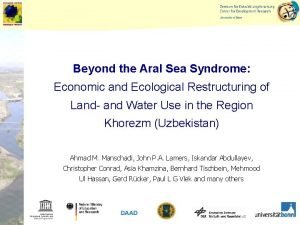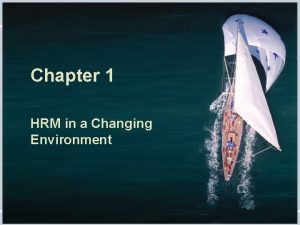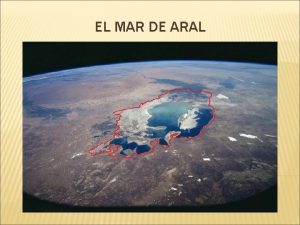The Aral Sea A Changing Environment The Aral












- Slides: 12

The Aral Sea A Changing Environment

The Aral Sea �The Aral Sea is located in the southern part of Kazakhstan and northern Uzbekistan. �Two major rivers feed the Aral Sea, the Amu Darya and Syr Darya. �Up until the 1960’s the Aral Sea was the fourth largest lake in the world. �In the 1960’s the USSR started to divert water from the two rivers to irrigate farms in the desert surrounding the Aral Sea.


The Aral Sea �Most of the water was diverted in order to grow cotton for the Soviet economy. �With the rivers being diverted, there was no longer enough precipitation to sustain the sea’s levels which has dropped about 75 feet over the last 40 years. �As the years went on the decrease in water level began to speed up.


The Aral Sea �As water levels began to drop the water became more shallow which in turn made the water warm quicker which increased evaporation. �Also, with the addition to an increase in farming, the sea became polluted from the fertilizers and other chemicals that became part of the runoff into the sea. �With an increase in pollution fish died off which impacted the food chain as well as those that relied on fishing as a job.

The Aral Sea �Large bodies of water cool the air as it travels over it. �With the shrinking of the Aral Sea, temperatures in the region began to rise which further evaporated the sea. �With a decrease in water and an increase in dirt, strong winds kick up dust and create large dust storms. �The dust from the storms blow dirt and sand into the farms which make it more difficult to farm.


The Aral Sea �By the 1990’s much of the Aral Sea became impossible to move ships through and many became part of a ship graveyard. �The Aral Sea has also impacted parts of central Asia that are further away. �Because of less water in the sea, storms that would pickup precipitation over the sea no longer produce as much snow in the mountains in central Asia.



The Aral Sea �Measures have been underway to increase the amount of water in the Aral Sea. �Dams have been built to try and retain water in the sea, but it may be too late to save the former large sea.
 Aral sea changed over time
Aral sea changed over time Aral sea syndrome
Aral sea syndrome The western siberian plain __________.
The western siberian plain __________. Chapter 1 hrm in a changing environment
Chapter 1 hrm in a changing environment Product-market screening criteria should
Product-market screening criteria should Organizing in a changing global environment
Organizing in a changing global environment Business ethics and changing environment
Business ethics and changing environment Sea stack diagram
Sea stack diagram Yellow sea and east china sea
Yellow sea and east china sea Hydra coral
Hydra coral Marlin symbolism
Marlin symbolism Led soldiers across hellespont into anatolia
Led soldiers across hellespont into anatolia Environment of business finance
Environment of business finance























